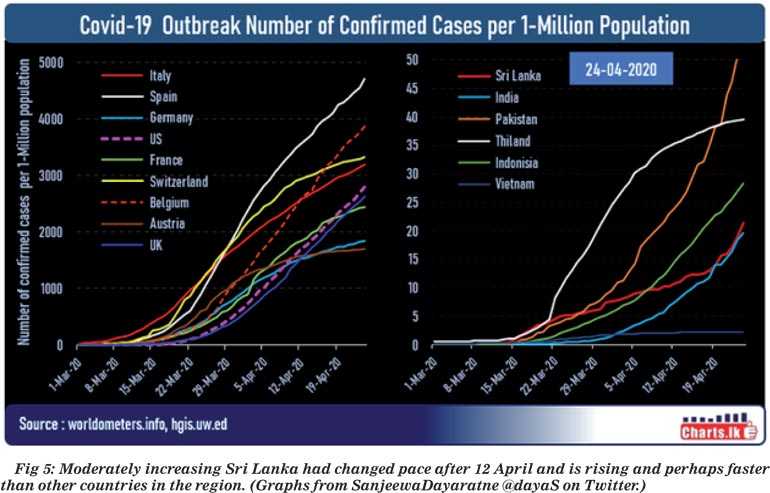Tuesday Dec 09, 2025
Tuesday Dec 09, 2025
Wednesday, 6 May 2020 00:55 - - {{hitsCtrl.values.hits}}
An outbreak of pneumonia of unknown reason was first reported on 31 December 2019 from Wuhan city in Hubei Province of China. On 7 January 2020, it was diagnosed as ‘Novel Corona Virus’. On 30 January, WHO declared it as a Public Health Emergency of International concern (PHEIC). On 11 February WHO renamed the disease as COVID-19 and on 11 March 2020 declared as pandemic. The incubation period is reported as 2-14 days – Situation report-26-4-2020, Epidemiology Unit, M/H&IM
By Dr. T Jayasingam
 The Government planned to open the country from lockdown on 27 April, which was then delayed for a week trying to bring back ‘normalcy’. But COVID-19 has accelerated during this period and reached the 500 mark on 26 April, just two days after reaching the 400 mark.
The Government planned to open the country from lockdown on 27 April, which was then delayed for a week trying to bring back ‘normalcy’. But COVID-19 has accelerated during this period and reached the 500 mark on 26 April, just two days after reaching the 400 mark.
The graphs indicate that we are in the ‘exponential growth’ of the infection. Opening of this country at this time would be an unwise decision that could cost a serious setback to the reduction of COVID-19.
Fig. I is from the Ministry of Health, Epidemiology Unit (26 April) and the cumulative figures calculated from the same and produced Fig 3. Fig. 2 was the reported information by the same office on 18 March. It is difficult to understand how the planners missed these indicators over time. One does not have to be an expert on COVID-19 or its infection to be competent enough to study trends and analyse them and relate to existing knowledge. The situation report for 18 March is given again from the same source.
There is a trend line of increase of the cases that led to the closure of the schools on 12 March and the universities on 16 March. But though some areas such as Puttalam were locked down the rest of the country was open until 20 March. Whether this was to accommodate the nominations for the General Election that closed on 19 March is commented upon, but earlier closure would have helped the country. The airports were declared closed for arrivals on 19 March.
The trend line shows a slowdown in terms of patients recognised each day and then starts to climb again after 12 April (Fig. 1). Whether this was due to the relaxing of the curfew in most of the country except for the selected hotspot districts needs investigation. However there had been reports of crowding during this period.
However, since then, the graph shows an acceleration that takes place much faster than before. It needs to be reminded that during this period following 16 April, intercity transport had been allowed and buses have been plying between cities including areas of earlier ‘restriction’. Whether this was also a cause for the rise is to be checked.
It is hard to believe that the authorities were unaware of this trend as this is taken from the ministry website and if so, it is a matter of utmost concern how the plans were made for opening the country on 27 April for almost ‘business as usual’.
Fig. 3 and 4 were computed on the same information of Fig. 1 but on a cumulative basis for better representation. Fig. 3 shows that we were almost zero for the first 50+ days and it was around 11 March that the numbers showed increase, which is detailed in Fig. 4.
It had taken us around 57 days for first 100 patients, 18 days for the second and eight days for the third, four days for the fourth and two days for the fifth. It is vividly clear from the graphs that we are on the exponential growth trend and trying to ignore it and behave as ‘business as usual’ will not result in reduction in the spread but most likely the reverse.
I also had a chance to look at the article by Dr. Ratnajeevan Hoole (‘Are we an independent Commission?’ – Colombo Telegraph, 27 April) where he discusses the postponement of the date for General Election which was to be on 25 April by the declaration of the President on 2 April and the associated scenarios.
In the context of the possible catastrophe that the country faces, it is foolhardy that the Election Commission had not looked at these data but fixed the date based on an imagined end of the corona saga on 2 May. This questions the rationale and expertise of these eminent persons to decide beyond their realm.
I think under the circumstances that we need to put the thought of June elections totally out of our minds and instead concentrate on coming out of the COVID-19 spread as we are on the threshold of a major increase as shown in the graph and time will be a crucial factor.
Fig. 5 shows the comparison of trends in many countries and Sri Lanka does not show a levelling impact but an increased trend of escalation after 12 April to 24 April even before the 500 mark was reached. It just concurs that we have little time and need to act fast.
Recommendations:
The following are submitted for consideration by the authorities and related agencies:
In this article I have only interpreted the data that is readily available from the State. The recommendations are basic and suggestions are rationale for consideration.
(The writer is Professor of Botany, Eastern University.)
